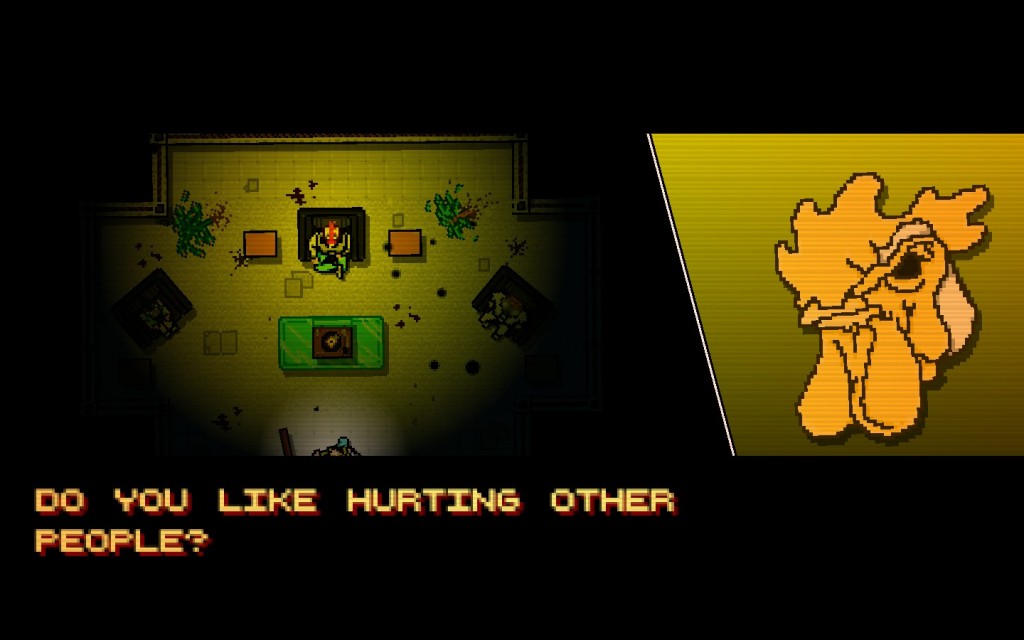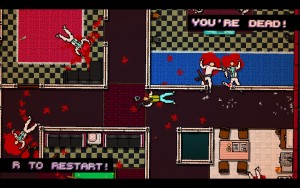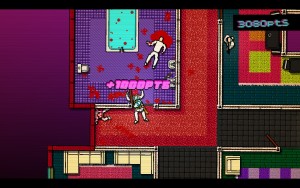 Abstract
Abstract
Hotline Miami is a game of massacre whose aesthetics are borrowed from an idealized version of
snuff films. Along with their bloodyness, it remediates their supposed means of production: a poor quality videocassette that is viewed on an old cathode ray tube television. Artifacts of these technologies contemporary to the game setting (the eighties) are hypermediated and used as a narrative device (rewind, white noise…). Along with the use of retro pixelated graphics, it creates a sense of uneasiness within the euphoria of the frantic die & retry gameplay.
Keywords
Hotline Miami; Snuff films; Glitch art; Horror; Remediation.
Article
Admittedly there are quite a few video games that meet the violent stereotype associated with the medium. Most of them are about guns and military power, but always rely on a strong moral about killing the bad guys and being a hero to the homeland. Others embody the full list of stigmas that are still sometimes associated with video game enthusiasts and can be summarized in one accusation: “You are a violent psychopath (and also do drugs)”. This is exactly what Hotline Miami (2012) is about. HLM is a game of massacre created by Jonathan “Cactus” Söderström and Dennis Wedin under the name of Dennaton Games. This top-down shooter puts the player in control of an unnamed protagonist wearing an animal mask and asked to “clean up” some places of their natural fauna of angry mobsters. Unfortunately, he usually leaves the place pretty messed up, with blood and guts splattered from floor to ceiling. HLM is all about over the top action and gore. The first is borrowed from eighties action movies and Nicolas Winding Refn’s Drive (2011), which the authors admit to be fond of (Edge Staff 2012, p. 2). Bloodiness on the other hand is reminiscent of another genre that has an even more controversial reputation than video games: snuff films.
Named after the verb “to snuff”, meaning to put out a candle, their content mostly refers to its slang usage: to kill someone. Right between pornography and horror, snuff movies are “clandestine short films, shot for rich and perverted amateurs, in which the actress is actually tortured and killed (usually a woman, sometimes a teenager)” (Campion-Vincent & Renard 2002, p. 12). According to journalist Sarah Finger’s extensive inquiry, their existence have yet to be proven, which makes them relevant not to film but to urban legend studies. People talk about in fear of an identifiable stereotype that has never been seen, except in works of fiction based on these rumors (ibid. p. 14). The stories are indeed dreadful: although not always about sex; snuff enthusiasts take pleasure in physical abuse, having an erotic and sadistic gaze toward torture and murder scenes (ibid. p. 12).
Born in the early seventies (Lapierre 2013, p. 12), “works of fiction exploiting the snuff movie theme are multiplying” a decade later (Campion-Vincent & Renard 2002, p. 14). HLM’s events take place in 1989, when this urban legend reaches mass media and settles in the collective imagination as a stereotype. Gore is not the only part of this game that makes it consistent with this setting. HLM’s aesthetics are based on technological artifacts borrowed from contemporary eighties technology, namely the VCR/VHS combo and early video games. It makes use of both remediation (transposing a media form into another) and hypermediation (highlighting the media’s specifications), two concepts described by Bolter and Grusin (2000). HLM borrows and reshapes the videotape as well as visual elements exclusive to old arcade and home video games. Although being the work of Wedin, the game’s art is consistent with Cactus’ style that “ricochets between primitive (he favors the chunky, barely expressive pixels of the Atari 2600) and gratuitously stylized” (Mastapra 2012). HLM is an archaic looking piece of software, lo-fi and ridden with technical imperfections.
Thus, playing HLM sometimes feels like watching a videocassette. The screen flickers with snow when Richard, a cock-headed man, asks: “Do you like hurting other people?” Merely hidden behind a curtain of downwards moving horizontal lines, signature of the good old cathode ray tube, is none other than a snuff movie VHS built on a stereotype encountered in Cronenberg’s Videodrome. In 1983, the snuff film rumor is “adapted to the contemporary media landscape” (Lapierre 2013, p. 72): it is not on film but on tape, leaving the big screen for the television and swapping cigarette burns for an image “riddled with interferences” (ibid. p. 97). HLM remediates the technical imperfections and poor cinematography of these bootlegs filmed by murderers who “just happen to have a camera in hand” (ibid. p. 96). When it follows the player-character, HLM‘s view angle slowly tilts from left to right, copying a crude hand-held unsteady shot highlighted by a hypermedia lo-fi artifact: the retro pixelated graphics lean into chunky aliased lines that emphasize the image’s imbalance. The amateur and minimalist stereotype is further reinforced with remediation of snuff movies overall shortness and the lack of editing (Campion-Vincent & Renard 2002, p. 13) into video game’s brief levels that have to be executed in one single long take.
However in HLM, it takes several tries to successfully slaughter all of the antagonists. They are in fact pretty aggressive, which leads to multiple deaths of the player-character who is immediately prompted to press “R TO RESTART!”. It is an integration in the gameplay itself of the quicksave/quickload feature, the “F5/F9” described by Triclot as inherently videoludic (2011, p. 22). By restarting over and over, the player can experience “the pleasure […] of replaying a sequence until it gives satisfaction” (ibid. p. 21). HLM goes even further than snuff movies in which “the height of assassination is to film the murder, to repeat it endlessly while watching the film” (Campion-Vincent & Renard 2002, p. 22) by acting the killing again and again, swapping one euphoric repetition for another. The “R” key acts both as a hypermediated “F9” quickload habit and as a remediated left-pointing rewind button. Superposing two kinds of media usage, it punctuates the play activity and also becomes a storytelling tool at the end of chapter 11, when pressing “R” to restart actually advances the story. Being mortally wounded and rewinding is part of the gameplay as well as of the scenario. HLM also remediates technical artifacts as a narrative device when, before the biker story begins, the screen freezes. Scarred with two horizontal noise lines, the image distorts to the sound of the VCR’s motor unrolling magnetic tape as it shows dates passing in reverse chronological order. The technical code of the rewinding is used to signify a full-fledged analepsys in the world of continuous flashback that is HLM.
With each restart, the level is left clean, with no traces of the previous mass murder attempts. The player-character then goes on rampage all over again, leaving behind him rounded crimson puddles that have anything but the consistency of the poorly detailed surroundings. Blood appears as liquid and contrasts with the angular pixelated setting: it explodes with each hit and spills slowly like an analog stain in a digital world. It stands out within the stylized low definition art style that blurs all of the graphic and gore content in a screen-wide mosaic. This may look like a censorship, but it mostly creates a strong sense of suggestion. The player knows they crushed bones, they have seen all of the animation and clicked through every one of the three movements it takes to break a skull open with a baseball bat. All that is left is guessing, wondering the rest of the crime that is already shown with great detail in one long take. No ambiguity is left: the player has been there and has done that. It was normal. Life holds little value in HLM, except from the bright colorful score that pops up to confirm each kill. Even dying provokes a satisfactory feeling of restarting. This classic video game discourse provokes an uneasy feeling when put into snuff film context. HLM creates a ludic approach to the act of killing by building up tension through difficulty of a frantic die and retry gameplay. It creates a state of vertigo, or “pleasure within panic”, a kind of play that Callois names ilinx and that, with the highscore motif, can be linked to (eighties) arcade (Triclot 2011, p. 51). Life and death are reduced to numbers evaluating grotesque murders committed to the beat of a mimetic fast paced bass filled musical soundscape.
And then, nothing. Corpses everywhere, ambient noise and the adrenaline rush aftermath. With this brutal change of pace, a threshold is crossed, leaving some quiet time to the player to reflect on their actions. What is left of their torture and murder is only a bloodshed. For a moment, they were one of “the executioners, sadistic brutes, [that] would usually be men, their faces masked or not being identifiable on the screen” (Campion-Vincent & Renard 2002, p. 13). They were not merely watching but producing a snuff movie. They were the murderer, the shape-shifting beast with dozens of faces none of which are human. The animal masks worn by the player-character are those of another stereotype from the horror genre: monsters. In the videoludic space, Perron describe them as dangerous: both a physical threat with lethal power and a menace to identity and moral order (2005). They are the kind that like to hurt other people, like the player did while enjoying the game. They felt empathy not for the victim but for the monsters and, realizing this, would “want to disrupt the relationship with the monsters” (ibid.). Fear comes from identification to deviant behavior, to one of the most gruesome urban legend that blends horror and pornography into an euphoric and uneasy display of violated corpses.
Within a screen filled with artifacts of a magnetic tape worn though repetitive viewing, Hotline Miami is tinted with the murky aura of snuff films. Through ultraviolence and glitch art, it remediates this urban legend, making it fun in an uneasy way, making a horror monster out of the player. Hotline Miami 2: Wrong Number, which should be released soon, is likely to resume this reflexion in a storyline involving what seems to be a commercial nineties slasher movie named Midnight Animal. Starring the Pig Butcher playable character, it is hinted to reenact the events that happened in 1989, furthering remediation with a film within the game that trailers suggest to be filled with digital aliasing and analog interferences.
– All images belong to their rightful owner. Academic intentions only. –
References
Bolter, J.D. & Grusin, R. (2000). Remediation: Understanding New Media. Cambridge: The MIT Press.
Campion-Vincent, V. & Renard J.-B. (2002). Rumeurs d’aujourd’hui (L’imaginaire de la violence urbaine), in De source sûre. Nouvelles rumeurs d’aujourd’hui (pp. 261-290). Paris: Payot. Revised version, retreived from http://pascalfroissart.online.fr/3-cache/2002b-campion-renard.pdf.
Edge Staff (2012). Hotline Miami: how Drive, drugs and Smash TV influenced one of the most intriguing games of 2012, Edge. Retrieved from http://www.edge-online.com/features/hotline-miami-interview-how-drive-drugs-and-smash-tv-influenced-one-of-the-most-intriguing-games-of-the-year/.
Lapierre, S. (2013). La légende urbaine des snuff movies : histoire, théorie, esthétiques, technologies. Master’s dissertation, Université de Montréal. Retrieved from http://hdl.handle.net/1866/10275.
Mastapra, G. (2012). Fast, Cheap, And Out Of Control, The Gameological Society. Retrieved from http://gameological.com/2012/06/fast-cheap-and-out-of-control/.
Perron, B. (2005). Coming to Play at Frightening Yourself: Welcome to the World of Horror Video Games, Aesthetics of Play. Retrieved from http://www.aestheticsofplay.org/perron.php.
Triclot, M. (2011). Philosophie des jeux vidéo. Paris: Zones.
Author contacts
Hugo Gelis – hugo@notainutilis.fr

This work is licensed under a Creative Commons Attribution-NonCommercial 4.0 International License.


